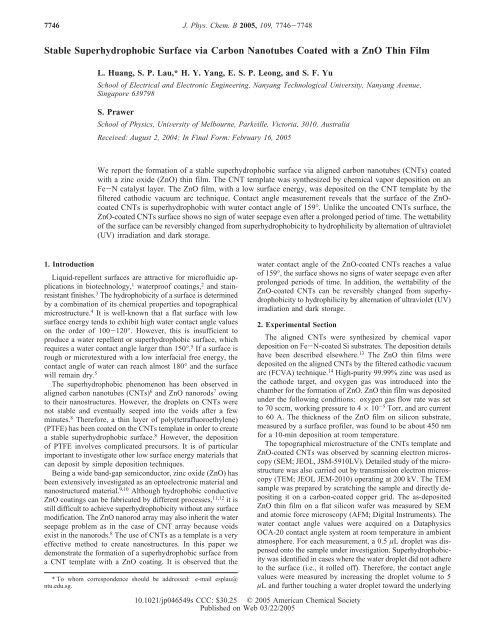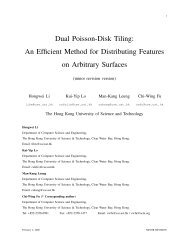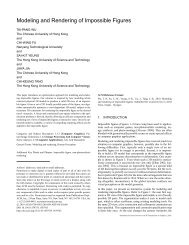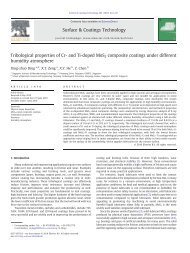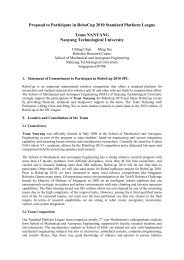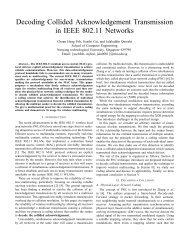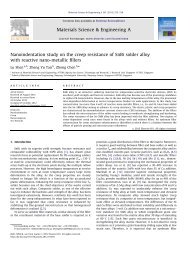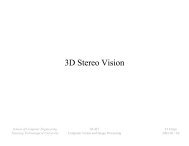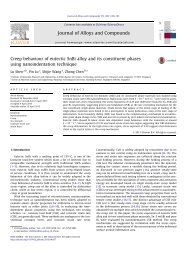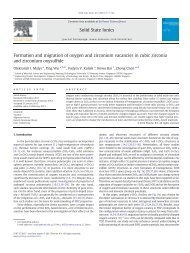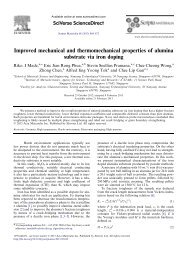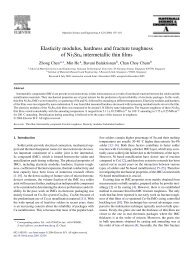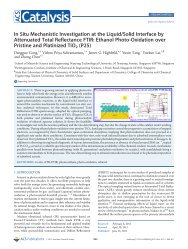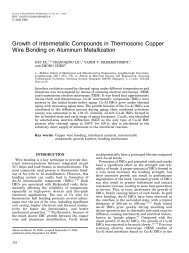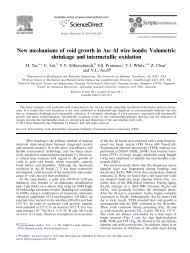View - Nanyang Technological University
View - Nanyang Technological University
View - Nanyang Technological University
Create successful ePaper yourself
Turn your PDF publications into a flip-book with our unique Google optimized e-Paper software.
7746 J. Phys. Chem. B 2005, 109, 7746-7748<br />
Stable Superhydrophobic Surface via Carbon Nanotubes Coated with a ZnO Thin Film<br />
L. Huang, S. P. Lau,* H. Y. Yang, E. S. P. Leong, and S. F. Yu<br />
School of Electrical and Electronic Engineering, <strong>Nanyang</strong> <strong>Technological</strong> UniVersity, <strong>Nanyang</strong> AVenue,<br />
Singapore 639798<br />
S. Prawer<br />
School of Physics, UniVersity of Melbourne, ParkVille, Victoria, 3010, Australia<br />
ReceiVed: August 2, 2004; In Final Form: February 16, 2005<br />
We report the formation of a stable superhydrophobic surface via aligned carbon nanotubes (CNTs) coated<br />
with a zinc oxide (ZnO) thin film. The CNT template was synthesized by chemical vapor deposition on an<br />
Fe-N catalyst layer. The ZnO film, with a low surface energy, was deposited on the CNT template by the<br />
filtered cathodic vacuum arc technique. Contact angle measurement reveals that the surface of the ZnOcoated<br />
CNTs is superhydrophobic with water contact angle of 159°. Unlike the uncoated CNTs surface, the<br />
ZnO-coated CNTs surface shows no sign of water seepage even after a prolonged period of time. The wettability<br />
of the surface can be reversibly changed from superhydrophobicity to hydrophilicity by alternation of ultraviolet<br />
(UV) irradiation and dark storage.<br />
1. Introduction<br />
Liquid-repellent surfaces are attractive for microfluidic applications<br />
in biotechnology, 1 waterproof coatings, 2 and stainresistant<br />
finishes. 3 The hydrophobicity of a surface is determined<br />
by a combination of its chemical properties and topographical<br />
microstructure. 4 It is well-known that a flat surface with low<br />
surface energy tends to exhibit high water contact angle values<br />
on the order of 100-120°. However, this is insufficient to<br />
produce a water repellent or superhydrophobic surface, which<br />
requires a water contact angle larger than 150°. 5 If a surface is<br />
rough or microtextured with a low interfacial free energy, the<br />
contact angle of water can reach almost 180° and the surface<br />
will remain dry. 5<br />
The superhydrophobic phenomenon has been observed in<br />
aligned carbon nanotubes (CNTs) 6 and ZnO nanorods7 owing<br />
to their nanostructures. However, the droplets on CNTs were<br />
not stable and eventually seeped into the voids after a few<br />
minutes. 8 Therefore, a thin layer of poly(tetrafluoroethylene)<br />
(PTFE) has been coated on the CNTs template in order to create<br />
a stable superhydrophobic surface. 8 However, the deposition<br />
of PTFE involves complicated precursors. It is of particular<br />
important to investigate other low surface energy materials that<br />
can deposit by simple deposition techniques.<br />
Being a wide band-gap semiconductor, zinc oxide (ZnO) has<br />
been extensively investigated as an optoelectronic material and<br />
nanostructured material. 9,10 Although hydrophobic conductive<br />
ZnO coatings can be fabricated by different processes, 11,12 it is<br />
still difficult to achieve superhydrophobicity without any surface<br />
modification. The ZnO nanorod array may also inherit the water<br />
seepage problem as in the case of CNT array because voids<br />
exist in the nanorods. 8 The use of CNTs as a template is a very<br />
effective method to create nanostructures. In this paper we<br />
demonstrate the formation of a superhydrophobic surface from<br />
a CNT template with a ZnO coating. It is observed that the<br />
* To whom correspondence should be addressed: e-mail esplau@<br />
ntu.edu.sg.<br />
water contact angle of the ZnO-coated CNTs reaches a value<br />
of 159°, the surface shows no signs of water seepage even after<br />
prolonged periods of time. In addition, the wettability of the<br />
ZnO-coated CNTs can be reversibly changed from superhydrophobicity<br />
to hydrophilicity by alternation of ultraviolet (UV)<br />
irradiation and dark storage.<br />
2. Experimental Section<br />
The aligned CNTs were synthesized by chemical vapor<br />
deposition on Fe-N-coated Si substrates. The deposition details<br />
have been described elsewhere. 13 The ZnO thin films were<br />
deposited on the aligned CNTs by the filtered cathodic vacuum<br />
arc (FCVA) technique. 14 High-purity 99.99% zinc was used as<br />
the cathode target, and oxygen gas was introduced into the<br />
chamber for the formation of ZnO. ZnO thin film was deposited<br />
under the following conditions: oxygen gas flow rate was set<br />
to 70 sccm, working pressure to 4 × 10-5 Torr, and arc current<br />
to 60 A. The thickness of the ZnO film on silicon substrate,<br />
measured by a surface profiler, was found to be about 450 nm<br />
for a 10-min deposition at room temperature.<br />
The topographical microstructure of the CNTs template and<br />
ZnO-coated CNTs was observed by scanning electron microscopy<br />
(SEM; JEOL, JSM-5910LV). Detailed study of the microstructure<br />
was also carried out by transmission electron microscopy<br />
(TEM; JEOL JEM-2010) operating at 200 kV. The TEM<br />
sample was prepared by scratching the sample and directly depositing<br />
it on a carbon-coated copper grid. The as-deposited<br />
ZnO thin film on a flat silicon wafer was measured by SEM<br />
and atomic force microscopy (AFM; Digital Instruments). The<br />
water contact angle values were acquired on a Dataphysics<br />
OCA-20 contact angle system at room temperature in ambient<br />
atmosphere. For each measurement, a 0.5 µL droplet was dispensed<br />
onto the sample under investigation. Superhydrophobicity<br />
was identified in cases where the water droplet did not adhere<br />
to the surface (i.e., it rolled off). Therefore, the contact angle<br />
values were measured by increasing the droplet volume to 5<br />
µL and further touching a water droplet toward the underlying<br />
10.1021/jp046549s CCC: $30.25 © 2005 American Chemical Society<br />
Published on Web 03/22/2005
Superhydrophobic CNTs Coated with ZnO Thin Film J. Phys. Chem. B, Vol. 109, No. 16, 2005 7747<br />
Figure 1. SEM images of (a) as-grown aligned CNT template, (b)<br />
topography of ZnO-coated CNTs, (c) cross-sectional view of ZnOcoated<br />
CNTs, and (d) TEM image of an individual ZnO-coated CNT.<br />
surface until the water droplet can be pulled down to the sample<br />
surface. UV light irradiation was carried out with a UV-<br />
ERASER (AT-402 UV EPROM ERASER). The wavelength<br />
of UV lamp was 253.7 nm with power density of 8 mW/cm 2 .<br />
3. Results and Discussion<br />
Our group has demonstrated room-temperature deposition of<br />
ZnO films with (002) preferential orientation by the filtered<br />
cathodic vacuum arc (FCVA) method. 14 The ZnO film is a very<br />
smooth, void- and particle-free surface. The SEM image (not<br />
shown) does not provide any information on the topographical<br />
microstructure. Atomic force microscopy (AFM) was used to<br />
observe the surface morphology of the ZnO film. It is observed<br />
that the ZnO film deposited on Si wafer is composed of wellfaceted<br />
grains, with average grain sizes within the range of<br />
40∼60 nm. The root-mean-square (rms) roughness of the ZnO<br />
film is 1.7 nm, and the peak-to-peak roughness is only 17.1<br />
nm. The shape of the water droplet on the ZnO film deposited<br />
on Si wafer has a contact angle of 103° (Figure 2a). The surface<br />
is hydrophobic with an ultralow surface roughness. Therefore,<br />
it is the low surface energy of the ZnO films that is responsible<br />
for the hydrophobic properties. This is consistent with the<br />
hexagonal wurtzite structure of ZnO, with their c-axis perpendicular<br />
to the substrate surface having the lowest surface energy,<br />
compared with other orientations of ZnO films. 7,11,12<br />
Figure 1a shows the SEM image of the aligned CNTs<br />
template grown on an Fe-N catalyst. It is observed that the<br />
average diameter and length of the CNTs are 250 nm and 2<br />
µm, respectively. The sample has a relatively low areal density<br />
of 3 × 10 8 CNTs/cm 2 , which is attributed to the selective growth<br />
of CNTs at the grain boundary of the Fe-N catalyst layer. 13<br />
An array of such a low areal density CNT template exhibits<br />
superhydrophobic properties, with a water contact angle of 146°<br />
(Figure 2b). But the water droplet is not stable and eventually<br />
disappears after more than 10 min. As reported by Lau et al., 8<br />
the eventual penetration of the water droplet on the low areal<br />
density of nanotubes surface is due to a hydrophilic surface of<br />
the nanotubes graphitic surface (a graphite material contact angle<br />
of 84∼86°). Therefore, the low surface energy of ZnO film<br />
deposited on the CNT template makes it possible to build a<br />
stable superhydrophobic surface by combining the nanostructures<br />
inherent in the aligned CNTs template.<br />
Figure 1b,c shows the SEM images of the topography and<br />
cross-sectional view, respectively, of aligned CNT template after<br />
being coated with a 450 nm thick ZnO film. It is observed that<br />
Figure 2. Photographs of water droplet shape on (a) ZnO thin film,<br />
(b) as-grown CNTs, and (c) ZnO-coated CNTs.<br />
the nanotube feature is lost. The ZnO coating on the CNTs<br />
template is composed of grains of 400-500 nm in diameter. A<br />
protruding feature with hundreds of nanometers in height has<br />
been formed, where CNTs are encapsulated by the ZnO. In<br />
addition, the ZnO is filled in the space between the individual<br />
nanotubes as shown in Figure 1c. Figure 1d shows the TEM<br />
image of an individual ZnO-coated CNT. It is clearly seen that<br />
ZnO is coaxially coated on the CNT where ∼450 nm and ∼100<br />
nm thick ZnO is on the tip and sidewalls of the CNT,<br />
respectively. A metal catalyst can also be observed near the tip<br />
of the CNT. The ZnO coating reduces the surface roughness of<br />
the CNTs template but maintains the nanostructures by the<br />
formation of protrusions. Modification of the CNTs template<br />
by the deposition of a ZnO thin film increases the water contact<br />
angle to 159° (Figure 2c). In addition, unlike the CNTs template,<br />
the ZnO-coated CNTs show stable superhydrophobicity. Figure<br />
3 shows the time dependence of water contact angle for the<br />
CNTs templates with and without ZnO coating. It is observed<br />
that the water contact angle of the CNTs template decreases<br />
linearly with time, from an initial value of 146° to 0° within 15<br />
min. But the contact angle of ZnO-coated CNTs remains<br />
constant, showing a stable superhydrophobicity (contact angle<br />
>150°). Since ZnO fills in the gaps between CNTs, it ensures<br />
water will not seep into the CNTs.<br />
Sun et al. 11 have demonstrated the photoinduced surface<br />
wettability conversion phenomenon on both TiO2 and ZnO thin<br />
films. UV illumination can decrease the water contact angle of<br />
ZnO film from 109° to 0°, meaning that hydrophobic ZnO can<br />
be switched to a highly hydrophilic surface. 11 Here, we<br />
investigated the UV illumination effect on the superhydrophobic<br />
ZnO-coated CNTs. Upon UV illumination for 5 h, the water
7748 J. Phys. Chem. B, Vol. 109, No. 16, 2005 Huang et al.<br />
Figure 3. Time dependence of water contact angle for aligned CNT<br />
template with and without ZnO coating.<br />
Figure 4. UV exposure time dependence of water contact angles for<br />
the ZnO film on the CNT template and Si wafer.<br />
contact angle is reduced to about 46°, indicating that the<br />
wettability changes from superhydrophobicity to hydrophilicity.<br />
After UV illumination, the samples were kept in the dark for<br />
about 12 h; the superhydrophobicity of the ZnO-coated CNTs<br />
template is recovered to the contact angle before UV illumination<br />
(i.e., 159°). The recovered superhydrophobic surface can<br />
be converted to the hydrophilic state again by exposing the films<br />
to UV light. Figure 4 shows the UV exposure time dependence<br />
of the water contact angles of ZnO film on the CNTs template<br />
and Si wafer. It is found that the water contact angle of ZnOcoated<br />
CNTs slowly decreased from 159° to 108° after 3hof<br />
UV irradiation and then rapidly decreased to 46° by extending<br />
one more hour of irradiation. After that, the water contact angle<br />
is reduced only slightly with prolonged periods of UV exposure.<br />
It is noteworthy that the photoinduced surface wettability<br />
conversion phenomenon of the ZnO-coated CNTs showed<br />
behavior similar to that of the ZnO film reported by Sun et<br />
al.; 11 however, the minimum water contact angles as well as<br />
the superhydrophobic-to-hydrophilic conversion rates of the<br />
ZnO-coated CNTs are different, although higher UV intensity<br />
(8 vs 2 mW/cm 2 ), shorter wavelength (253.7 vs 365 nm), and<br />
longer illuminated time (5 h vs 20 min) were used in our<br />
experiment. These differences may be attributed to surface<br />
chemical states of ZnO films, which is strongly dependent on<br />
deposition method. It suggests that ZnO films produced by the<br />
FCVA technique exhibit less surface defective sites as compared<br />
to the spray pyrolysis method. 11 The wettability of a surface is<br />
primarily determined by its chemical composition and roughness.<br />
4,5 UV irradiation can only change the chemical states of<br />
the surface, which promote water droplets to dissociatively<br />
absorb on them. 11 The UV illumination generates electronhole<br />
pairs in the ZnO film. Some of the holes can react with<br />
lattice oxygen, leading to the formation of surface oxygen<br />
vacancies; while some of the electrons react with lattice Zn 2+<br />
to form Zns + , surface trapped electron sites. Zns + tends to react<br />
with oxygen molecules adsorbed on the surface. The formation<br />
process of Zns 2+ is represented by<br />
+ 2+ -<br />
Zns + O2 f Zns + O2<br />
Water molecules may coordinate into the oxygen vacancy sites,<br />
which leads to dissociative adsorption of the water molecules<br />
on the surface. The process gives rise to increased water<br />
adsorption on the illuminated ZnO-coated CNTs.<br />
As shown in Figure 4, the minimum water contact angle of<br />
ZnO-coated CNTs after UV irradiation is about 38°, not<br />
sufficient to be classified as superhydrophilic. The wettability<br />
of the ZnO-coated CNTs can be reversibly changed from<br />
superhydrophobicity to hydrophilicity by alternation of ultraviolet<br />
(UV) irradiation and dark storage. In fact, the water<br />
contact angle of the ZnO coated on the Si wafer is changed<br />
from 103° to 37° after 5hofUVillumination. The superhydrophobic<br />
surface needs longer illumination time (i.e., 8 h) to<br />
reach the water contact angle of 37°; this may be due to the<br />
difference in functional surface area. It suggests that the<br />
photoinduced wettability conversion is independent of its surface<br />
structure but depends on its surface chemical composition.<br />
Further experiment is needed to verify this point.<br />
Conclusions<br />
We have demonstrated the formation of a stable superhydrophobic<br />
surface via aligned carbon nanotubes coated with a<br />
ZnO thin film. ZnO-coated CNTs possess the nanofeatured<br />
topography inherent in the aligned CNTs template and the low<br />
surface energy of ZnO film so as to achieve a stable superhydrophobic<br />
surface. Reversible superhydrophobicity to hydrophilicity<br />
transition of ZnO-coated CNTs is observed by alternation<br />
of UV irradiation and dark storage. On the basis of this<br />
study, the superhydrophobic surface from nanostructure materials<br />
may have potential applications in microfluidic devices.<br />
Acknowledgment. This work was supported by the Agency<br />
for Science, Technology and Research, Singapore (Projects 022<br />
101 0020 and 022 1010033)<br />
References and Notes<br />
(1) Meldrum, D. R.; Holl, M. R. Science 2002, 297, 1197-1198.<br />
(2) Erbil, H. Y.; Demirel, A. L.; Avci, Y.; Mert, O. Science 2003, 299,<br />
1377-1380.<br />
(3) Nakajima, A.; Hashimoto, K.; Watanabe, T.; Takai, K.; Yamauchi,<br />
G.; Fujishima, A. Langmuir 2000, 16, 7044-7047.<br />
(4) Wenzel, R. N. Ind. Eng. Chem. 1936, 28, 988-994.<br />
(5) Lafuma, A.; Quéré, D. Nat. Mater. 2003, 2, 457-460.<br />
(6) Li, S.; Li, H.; Wang, X.; Song, Y.; Liu, Y.; Jiang, L.; Zhu, D. J.<br />
Phys. Chem. B 2002, 106, 9274-9276.<br />
(7) Feng, X.; Feng, L.; Jin, M.; Zhai, J.; Jiang, L.; Zhu, D. J. Am.<br />
Chem. Soc. 2004, 126, 62-63.<br />
(8) Lau, K. K. S.; Bico, J.; Teo, K. B. K.; Chhowalla, M.; Amaratunga,<br />
G. A. J.; Milne, W. I.; McKinley, G. H.; Gleason, K. K. Nano Lett. 2003,<br />
3, 1701-1705.<br />
(9) Huang, M. H.; Mao, S.; Feick, H.; Yan, H. Q.; Wu, Y. Y.; Kind,<br />
H.; Weber, E.; Russo, R.; Yang, P. D. Science 2001, 292, 1897-1899.<br />
(10) Nomura, K.; Ohta, H.; Ueda, K.; Kamiya, T.; Hirano, M.; Hosono,<br />
H. Science 2003, 300, 1269-1272.<br />
(11) Sun, R. D.; Nakajima, A.; Fujishima, A.; Watanabe, T.; Hashimoto,<br />
K. J. Phys. Chem. B 2001, 105, 1984-1990.<br />
(12) Li, M.; Zhai, J.; Liu, H.; Song, Y. L.; Jiang, L.; Zhu, D. B. J. Phys.<br />
Chem. B 2003, 107, 9954-9957.<br />
(13) Huang, L.; Lau, S. P.; McCulloch, D. G.; Zhong, W. H.; Fu, Y.<br />
Q.; Tay, B. K.; Sun, C. Q. Carbon 2005, 43, 654-657.<br />
(14) Wang, Y. G.; Lau, S. P.; Lee, H. W.; Yu, S. F.; Tay, B. K.; Zhang,<br />
X. H.; Tse, K. Y.; Hng, H. H. J. Appl. Phys. 2003, 94, 1597-1604.<br />
(1)


